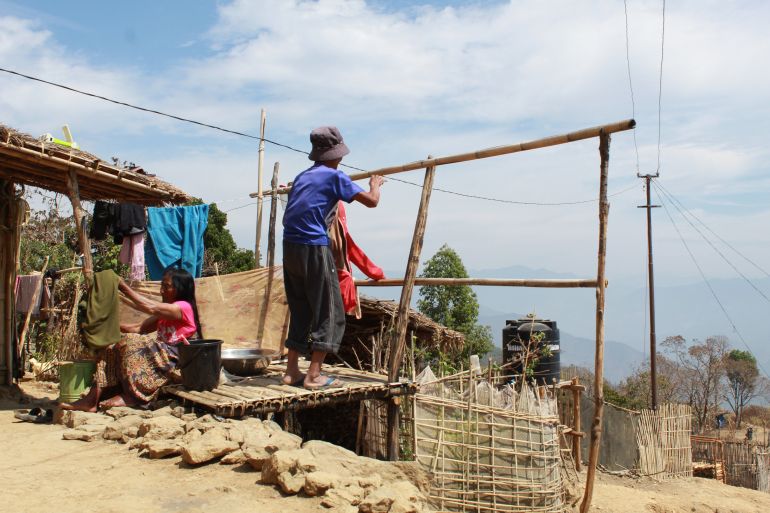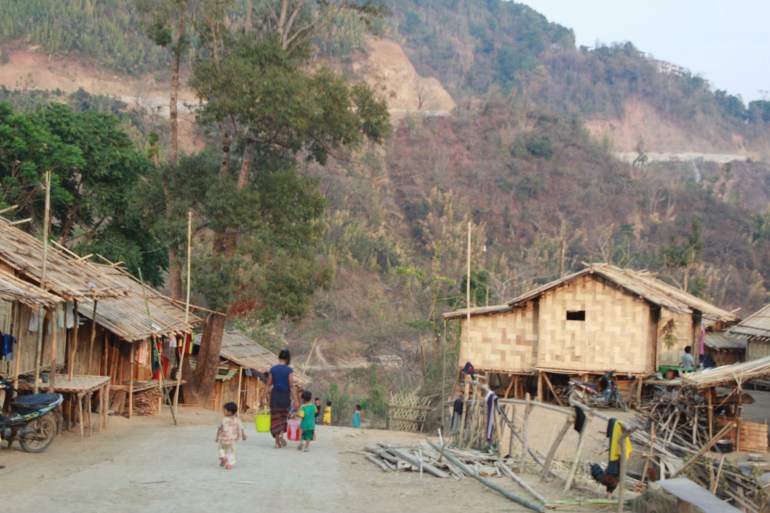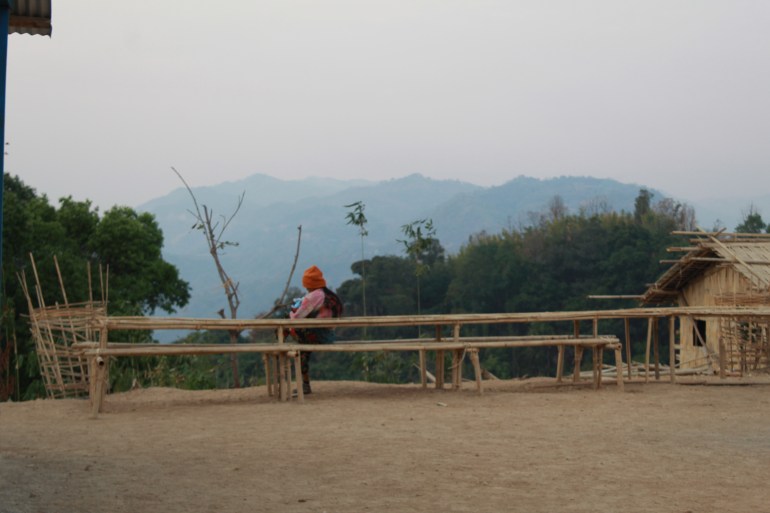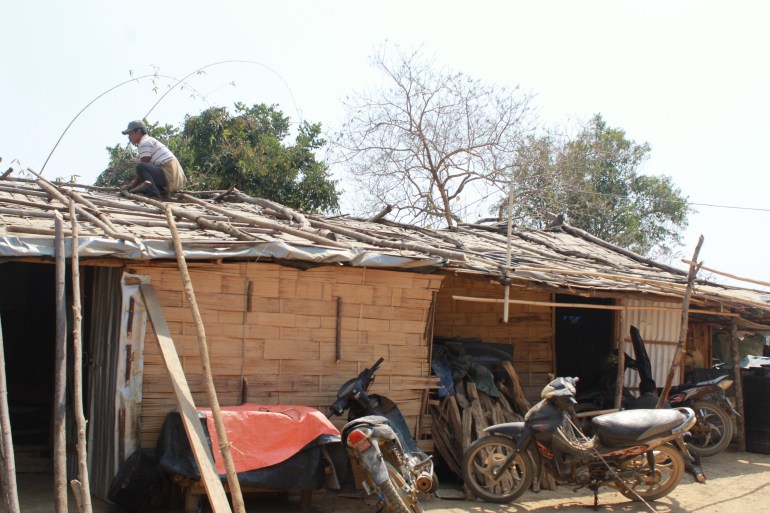Myanmar’s striking civil servants: Displaced, forgotten, but holding on
The Civil Disobedience Movement remains a key pillar of resistance to military rule, but those involved are paying a heavy price.

Mizoram, India – From the patio of a concrete house overlooking the verdant mountains stretching from the Indian state of Mizoram to her native Chin State in neighbouring Myanmar, Grace wistfully recalls her days working for her country’s education department.
“Even though the salary was low, I really valued that work,” she said. “I stayed in the office more than my own home, and I felt closer to it.”
Keep reading
list of 4 itemsUN urged to ‘cut ties’ with Myanmar coup leaders after Griffiths visit
H&M probes alleged Myanmar factory abuses as pressure intensifies
‘Dramatic increase’ in Myanmar war crimes, UN probe finds
But when the military seized power in a coup in February 2021, she could not bring herself to serve under its administration.
“I realised that as a government employee, there was no use in going to work any more,” she said. “I had never been absent without permission, but this time, I did it of my own will.”
At the time, civil servants across Myanmar were raising three-fingered salutes to signify their support for the pro-democracy movement and optimism was high that nonviolent resistance would be enough to push the military to step down. In total, about 420,000 people joined the strikes according to the National Unity Government (NUG), a parallel administration made up of activists and politicians who oppose the coup.
Two and a half years later, the country is embroiled in a worsening conflict between the military and anti-coup forces, and while the Civil Disobedience Movement (CDM) continues to serve as a key pillar of resistance to military rule, the estimated 214,000 still participating are paying a heavy price.
The military has sought them out as part of its wider crackdown on all opposition, which has in total seen more than 24,000 people arrested and 4,000 killed according to the Assistance Association for Political Prisoners, a rights documentation group that has been tracking the situation.
CDM participants have been jailed and in some cases allegedly tortured to death during military interrogation, driving thousands to go into hiding or flee the country. Adding to their hardships, many have also suffered as a result of the deepening war. Since the public began taking up arms against the coup in April 2021, the military has retaliated with bombings, artillery fire and arson, forcing more than 1.6 million people from their homes since the coup.
In September 2021, the military fired artillery into Grace’s native town of Thantlang, launching a year-long arson campaign that reduced most of the town to rubble and displaced all of its 10,000 residents. Grace and her family fled west, crossing the Tiau River, which separates Myanmar from India, and taking refuge in a makeshift camp in Mizoram’s Lawngtlai district.

There, heavy wind and rain blew down their shelter three times before they managed to rent a house in a small village. Now, Grace raises chickens and pigs and tends to a small garden, but mainly relies on remittances from relatives abroad and donations from local churches to get by.
“We have difficulties living away from home, but we are following our own will and we won’t give up,” she said.
Grace is one of 14 on-strike civil servants and family members interviewed for this report from border camps and villages in Mizoram’s Lawngtlai and Siaha districts. They described facing significant hardship since joining the CDM but said they are committed to continuing their strikes. Most preferred to be identified by pseudonyms to protect their family members from military reprisals.
‘I didn’t want to fire at the people’
Launched by healthcare professionals the day after the coup, the CDM quickly spread across the country. Those not participating have since faced intense social pressure to join, while assassinations targeting those who have not joined the movement and armed attacks on military-run facilities, often carried out by anti-coup armed groups, have made it dangerous to report to work.
But for many, the decision not to work under the military’s administration is mainly a moral choice. “After the coup, the people protested peacefully and the military gave the police orders to fire at them. I didn’t want to fire at the people, so I joined the CDM,” said Salai Bawi Thang, a pseudonym for a police officer who abandoned his duty station in the Chin State capital of Hakha in May of 2021.
Ko Maung, a police officer who had been stationed in Thantlang and who also prefers not to share his real name, reached his breaking point when the military began attacking the town that September. “It was torturing people, burning houses, killing people,” he said. “I couldn’t bear it.”
Defecting police officers were among the first to flee the country, often with the support of underground networks. “It was difficult. We came by [motor]cycle and we didn’t have any of our belongings,” said Salai Mang Ceu, who left his duty station in Hakha in April of 2021 with his wife and two children, and who is also using a pseudonym.
As clashes escalated between the military and anti-coup resistance forces in Myanmar’s northwest, CDM participants were joined by others fleeing the violence. Most crossed into Mizoram, which has taken in more than 52,000 people from Myanmar since the coup according to the Chin Human Rights Organisation. It estimates that about one-third of those who fled to Mizoram now live in camps, with the rest renting homes or staying with relatives.
While those seeking refuge found a safe haven in the northeastern border state, they have nonetheless faced a new set of challenges. India’s central government does not recognise them as refugees and has offered them no humanitarian support. Many have struggled to find ways to survive.
“Work is scarce here and I was near retirement, so I’m not able to do manual labour any more,” said Salai Mang Ceu, the police officer formerly stationed in Hakha. He now rents a house in a border village for 3,500 rupees ($42) a month but has been unable to provide for his family’s basic needs. “We receive rice and oil donations, and with that, we survive,” he said.
Cung Cung, the preferred nickname of a teacher who joined the strike, takes wage labour jobs whenever he can find them, earning 500 Indian rupees ($6) a day. “Even if I worked every day, I could only earn 12,000 ($145) a month,” said the father of five. “For house rent, sending my children to school, and daily survival, it’s not enough, and I don’t have work every day, just once or twice a week.”

His sister, who also joined the strike, initially worked at a restaurant but quit after two months because she only earned 5,000 rupees ($60) a month despite working more than 60 hours a week. “The income wasn’t nearly enough… and I couldn’t give any time to my family,” she said.
‘More and more difficult’
Outside support has also dwindled. The crowdfunding campaigns that proliferated in the months after the coup have largely tapered off or refocused their attention on the armed resistance movement, while support from the National Unity Government has followed a similar trajectory.
Although the NUG pledged in April 2021 to pay the full salaries of civil servants who joined the strike, its officials told a press conference a year later that it had shifted the focus of its financial support to the armed resistance movement, even while acknowledging that the decision probably meant fewer people participating in the CDM.
Kyaw Zaw, a spokesperson for the NUG president’s office, told Al Jazeera in written comments that the NUG recognises the “enormous challenges” faced by CDM participants and has “sought to address them as best [as] possible.” But he added that the scale of the needs, combined with a “historic confluence of other challenges” including the military’s attempts to block the flow of funds, have hindered these efforts.
CDM participants in Mizoram said that defecting police officers and military personnel received 1,000 to 2,000 rupees ($12-$24) from the NUG once every two to three months. “The monthly allowance isn’t enough,” said Salai Bawi Thang, formerly a police officer in Hakha. “We have to stand for ourselves here and search for our own means of survival.”
People from other professional sectors, meanwhile, said they had received nothing from the NUG at all since fleeing the country. “I heard the NUG helps CDM police but, for me, I haven’t received any support,” said Van Kung, who used to work in the government’s education department in the capital city of Naypyidaw. Now, he sells a traditional corn soup known as sabuti in a village in Mizoram’s Lawngtlai district.
In-kind assistance from local charity groups and non-governmental organisations also appears to be drying up. “Some groups provide rice and oil as much as they can but not regularly,” said Tung Tung, a leader of a collective of CDM participants in Mizoram’s Siaha district who worked for the education department back in Myanmar and who requested to go by a pseudonym.
“Local people helped as they could, but now it has been a while and they can’t provide regular support for people’s daily living any more, so it got more and more difficult.”
CDM participants’ families have also been affected. Gloria Par, who is 16 and has also been given a pseudonym, fled to Mizoram with her family in March 2021, after her mother, a medical doctor, joined the strikes. “It was pretty rough here at first because I didn’t know the language. I was not familiar with this place at all,” she said.

She has since enrolled in the local high school and her situation has significantly improved but, for some, the transition has been much harder. A 21-year-old who fled to Mizoram after his father defected from the police, has been unable to resume his university studies because he lacks the necessary credentials.
“I should have already graduated and started working but now I don’t have that option,” he said, preferring not to share his name for fear of reprisals. “Sometimes, if there are activities for youth to do at the church, I go and participate, but there isn’t much for young people to do here – just sit around.”
Daw Khin Khin, a pseudonym for the wife of a police officer who defected in May of 2021, said she often feels a sense of despair when considering her situation. “I always have to think about how we will survive and how my children will go to school,” she said. “If there was work, I would do it for my children, for my family, [but] I don’t have any hope as a refugee in this situation.”
For Grace, seeing her son struggle in a new place and being unable to provide for him has been the hardest to bear. To cope, she focuses on the life she intends to lead in a future democratic Myanmar. “I will go back to work. I will return to Thantlang and I will rebuild my house,” she said.